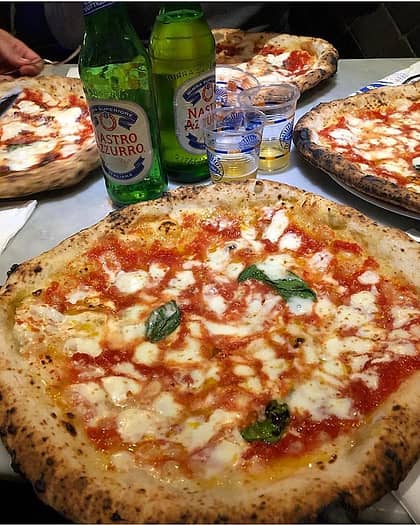- Home
- Experiences
- Three Days in Naples
Three Days in Naples

Trying to see the highlights in Naples in three days isn't easy: Naples may not be a huge city, but it has thousands of years of history and is rich in museums of every kind, churches, castles, and a surrounding area that is also home to natural and cultural treasures.
Our first piece of advice to plan three perfect days in Naples is to concentrate on the city center, putting aside the surrounding area for the following days or for a future visit.
During your weekend in Naples, the Naples Pass is the perfect tool to maximize your time and visit as many attractions as possible. With the Naples Pass, you can access over 100 tourist sites, including the National Archaeological Museum, the Pompeii Archaeological Park, and the Royal Palace, all while saving time and money. The pass also allows you to skip the lines and, in versions that include public transportation, move freely around the city.




An Itinerary for Three Days in Naples
An Itinerary for Three Days in Naples
Considering that you will have two and a half days of time to visit once you factor in travel times, here is our suggested itinerary for a perfect short break or weekend trip to Naples:
Day one (afternoon): the seafront and Castel dell'Ovo
Day two: Historic center and dinner in Vomero
Day three: Piazza Plebiscito and environs
If you find you have a bit of extra time, you can spend the day visiting Mt. Vesuvius and the archaeological ruins of Pompeii and Herculaneum, perhaps even making a stop to taste wine and other local gourmet products.
A Tip
Naples has become a popular tourist destination for visitors from across the globe and can be very crowded in the summer high season. To best appreciate the city, we suggest you avoid the months of July and August when the city is hot and crowded. Choose instead dates in the spring or fall when temperatures are milder and you can enjoy Naples at its best. Keep in mind that Naples is busy during holiday weekends all year round.
When to Visit Naples
Day One: The Seafront
Day One: The Seafront
Begin with the most iconic spot in the city, the seafront promenade. This walkway starts in Santa Lucia and runs to Mergellina, around three kilometers away; some stretches are pedestrian only. In addition to taking in beautiful views of the bay, Mt. Vesuvius, Capri, and the Sorrentine Peninsula, you can admire some of the city's most famous and beloved landmarks along seafront promenade between Via Partenope and Via Caracciolo.
Begin at the picturesque Fontana del Gigante in Santa Lucia, and admire the views of Mt. Vesuvius and the Bay of Naples before continuing on to visit one of the most important monuments along the waterfront in Naples: Castel dell'Ovo and the Borgo Marinari fishing village. Castel dell'Ovo is a fortress originally built by the Normans, though it was modified during the subsequent Angevin and Aragon dynasties.
According to a popular local legend, the name Castel dell'Ovo, or Egg Castle, comes from a magical egg placed inside a cage and hidden inside the castle by the Roman poet Virgil. The egg is said to keep the castle standing with its powers; if the egg were to break, there would be catastrophic consequences for the fortress and all of Naples.
Visiting Castel dell'Ovo
Hours: open daily from 9AM to 7:30PM (6:30 in winter). Sundays from 9AM to 2PM (1PM in winter).
Directions: metro line 1, Toledo stop or bus R2 to Piazza Municipio. Both are about 1.5 km away.
Tickets: entrance to the Castel dell'Ovo is free.

Castel dell'Ovo stands on the historic islet of Megaride, today connected to the mainland with a charming causeway and crowded with the bars and restaurants of Borgo Marinari. This is the perfect spot for a romantic walk or dinner featuring fresh seafood or traditional Neapolitan dishes. For an authentic plate of spaghetti con le vongole, we recommend the O' Tabaccaro restaurant in the heart of Borgo Marinari, a rustic family-run trattoria. Alternatively, book a table at Da Zi' Teresa for more elegant surroundings.
For a traditional Neapolitan aperitivo, stop at one of the stands along the waterfront for a cold beer and warm tarallo.
Continuing along the promenade, you can relax at the Villa Comunale, one of the most important historic parks in Naples, or visit the Museo Pignatelli, a collection of porcelain, paintings, precious furnishings, and antique carriages displayed in the neoclassical villa of the same name. (Villa Pignatelli is open daily from 8:30AM to 5PM. Closed Tuesdays).
This is a great area to tuck into an authentic Neapolitan pizza "with views of the sea and Mt. Vesuvius" at Da Sorbillo al Lungomare. This popular spot is located on the corner of Piazza Vittoria and the promenade and has tables outside with a view. In addition, here you can taste the famous Da Sorbillo pizza without having to wait in line for hours like at their restaurant in the historic center (though prices are a bit higher here). If you'd like to enjoy a seafood dinner, try Crudo Re on nearby Via Poerio.
Day Two: The Historic Center
Day Two: The Historic Center
Today, leave the waterfront behind and delve into the captivating historic heart of the city to continue your three days in Naples. Thick with storied palaces, churches, and museums, the city's old town is best explored on foot... wander the warren of narrow lanes and tiny squares, admire the picturesquely aging Baroque facades, and be surprised and delighted at the hidden piazzas and courtyards.
To visit Naples' historic center in one day, we suggest following this route:
First stop: Chiesa di San Domenico Maggiore
The monumental church complex of San Domenico Maggiore is an ideal jumping-off point to begin your exploration of the historic center of Naples, thanks to its location right in the heart of the district. This church was founded in 1283 and is home to a pipe organ from 1640 that is still in working condition. It is uniquely placed so that the apse rather than the main facade overlooks Piazza San Domenico Maggiore.
While you're here, stop for a treat at Pasticceria da Scaturchio, considered one of the best in the city for a traditional sfogliatella or babà al rhum.
Second stop: Cristo Velato (The Veiled Christ)
This masterpiece of 18th-century sculpture is located in the Sansevero Chapel not far from Piazza San Domenico Maggiore. We recommend avoiding the most crowded midday hours or booking your ticket in advance.
Tickets for Naples Walking Tour with Sansevero Chapel & The Veiled Christ
Visiting the Cristo Velato:
Hours: Daily from 9:00AM to 7:00PM. Saturday from 9:00AM to 8:30PM (from May to November, 2019). Closed Tuesdays.
Ticket prices: €8
Visiting the Veiled Christ
Third stop: Via Tribunali
Continue your walking tour of the historic center during your short break in Naples by strolling down the striking Via dei Tribunali, one of the main thoroughfares in Naples lined with shops, pizzerias, and trattorias. This vibrant stretch of road crowded with street vendors and Neapolitans truly captures the feisty spirit of the city. This is also an ideal spot to sample traditional Neapolitan dishes, including the city's tempting array of street foods like la pizza al portafoglio or il cuoppo, a paper cone of fried seafood.

A number of the most famous pizzerias in the historic center are located along Via dei Tribunal, incuding Da Sorbillo, Di Matteo, Al Presidente, Dalla Figlia del Presidente.... we don't recommend one above another because the traditional pizza is excellent at all of them. A bit farther up towards Forcella, you can stop at Da Michele, perhaps the most famous of Naples' pizzerias. Keep in mind that there is always a bit of a line, and you will need to go inside to leave your name on the waiting list to be called when your table is ready.
An Unusual Stop
While exploring along Via dei Tribunali, be sure to stop at the Church of Santa Maria delle Anime del Purgatorio ad Arco, known for centuries as home of the cult of “anime pezzentelle”, a popular devotional practice in the city in which skulls of unidentified deceased are believed to represent souls in Purgatory. One of the most famous is Lucia, a skull with a bridal veil that is considered the guardian angel of young brides by Neapolitans. In the underground burial grounds at the Complesso del Purgatorio ad Arco, which we suggest you visit while in Naples for three days, you can take in the ossuary at the heart of this folkloristic cult of the "anime pezzentelle".
Fourth stop: the nativity scene artisans of San Gregorio Armeno
Crossing Via Tribunali at a right angle, Via San Gregorio Armeno is a must-see when in Naples for a short break. This short and narrow lane is home to the famed nativity scene artisans of Via San Gregorio Armeno. The workshops are functioning and open to business all year round, and spill over into neighboring lanes. The area is very crowded during the Christmas holidays, of course, and on December weekends it can be a challenge to walk in the crush of shoppers.
If you have time and aren't too footsore, before browsing the workshops on Via San Gregorio Armeno, take a look at the city's Duomo, the Cathedral of San Gennaro. Admire the Royal Chapel of the Treasure of San Gennaro, a symbol of the city's most beloved religious traditions.
Visit San Gregorio Armeno
Fifth stop: Spaccanapoli
Your walking itinerary through the historic city of Naples now takes you to perhaps the most emblematic stretch of road in the city: the"decumano inferiore", best known as Spaccanapoli. This bustling, narrow road shoots straight through the city's heart and is about a kilometer long. Dividing the downtown in two halves, Spaccanapoli is home to some of the most important historic monuments and palaces in the city, including Palazzo Carafa, the Dio Nilo statue, the Church of Gesù Nuovo, and the spectacular Basilica of Santa Chiara, consecrated in 1340. Be sure to take in the famous majolica cloister at Santa Chiara, the crown jewel of the complex. The cloister is open daily from 9:30AM to 5:30PM (Sunday from 10AM to 2:30PM) and tickets cost EUR 6.
Sixth stop: Piazza Dante
End your walk through the historic center with a stop in Piazza Dante, one of the most important squares in the city. Browse the historic stands of booksellers at Port'Alba, the artisan musical instrument workshops along Via San Sebastiano, and the ruins of the ancient Greek city walls in Piazza Bellini, a bustling square lined with trendy bars perfect for an aperitivo. You can even stop here for dinner: located directly on Piazza Dante, Il Leon d'Oro offers traditional Neapolitan dishes and a surprising array of appetizers and small bites. For a more modern take on Neapolitan classics, dine at Stanza del Gusto on nearby Via Costantinopoli.
If you are keen to explore an additional neighborhood in the city, take the underground metro (line 1, Dante stop to Vanvitelli) to hilltop Vomero for dinner in one of the many popular restaurants in this vibrant district known for its nightlife.
Day Three: Piazza Plebiscito
Day Three: Piazza Plebiscito
The last day of your perfect three days in Naples is dedicated to another district of the city center that is rich in history and beauty: Piazza Plebiscito, the Quartieri Spagnoli, and the Maschio Angioino.
The first stop is at Castel Nuovo, known in Naples and across the globe as the Maschio Angioino (open from 8:30AM to 6:30PM daily except Sunday), a medieval defensive castle that once sat directly on the waterfront. Watchtowers, crenelated ramparts, and majestic halls take you back in time; bed sure to peer down at the vast excavation directly below the castle that is bringing to light an ancient Roman port.
Stroll from the castle to Piazza del Plebiscito to take in the neoclassical architecture of the Church of San Francesco di Paola, a popular venue for weddings among Neapolitans. Directly opposite, the Palazzo Reale, or Royal Palace (open daily from 9AM to 7PM, closed Wednesdays. Tickets: EUR 6) occupies an entire side of the square. Residence of the city's Spanish rulers from 1734 to the unification of Italy in the mid-1800s, this Bourbon palace is home to opulent apartments, hanging gardens, precious artworks, and breathtaking halls. The legendary San Carlo Opera House, one of the oldest and most prestigious in the world, is also part of the royal complex.
Visit the Royal Palace and San Carlo Opera House
A Traditional Challenge
Try to do the “horse trick”: stand directly in front of the entrance to the Palazzo Reale and twirl around a few times. Then close your eyes and try to walk across the square towards the church while keeping them closed. The challenge is to pass through the center of the equestrian statues in the center of the piazza. It seems like it would be easy, but only rarely is someone able to make it through!
Directly opposite Teatro San Carlo, admire the stunning Galleria Umberto I, stopping to rest with a traditional sfogliatella and espresso. Nearby, you can get your coffee fix at the landmark Caffè Gambrinus, one of the most storied in Naples.

After visiting Piazza Plebiscito and its highlights, stop for lunch in one of the many authentic trattorias in the Quartieri Spagnoli, a working-class district that was famous until just a few years ago for being a dangerous center of crime but is now one of the most picturesque and traditional neighborhoods in the city. Weave through its warren of narrow lanes to dine at Locanda Dei Borboni or Trattoria 'A Pignata, try the pasta, fagioli, and seafood dish at Trattoria Antica Capri (pictured here), or savor the famed pasta e patate at Nennella (keep in mind that you may need to wait to get a table).
Finish off your three days in Naples with a few hours of shopping along nearby Via Chiaia, Piazza dei Martiri, and Via Roma (that most locals continue to call by its historic name of Via Toledo).
Have an extra day?
If you have one more day in Naples, there are a number of excellent city museums that are worth a visit, including Capodimonte and the National Archaeological Museum, one of the most important in Italy. Otherwise, take in the Charterhouse of San Martino and nearby Castel Sant'Elmo, both of which boast sweeping views across the city. You can also organize a day trip to Mt. Vesuvius and the ruins of Pompeii with a rental car or one of the many local tour companies.
With art, history, folklore, and food...your three days in Naples are sure to be unforgettable, and you'll look forward to coming back to explore the surrounding area!
FAQ - Frequently asked questions
What is the old town of Naples called?
Partenope was the original Greek name for the city of Naples, and it dates back to the 9th century BC. The name comes from the siren Parthenope, who was said to have founded the city. Parthenope was one of three sirens who attempted to lure Odysseus off course with their singing. When Odysseus resisted their temptation, Parthenope drowned herself in despair and was washed ashore at Naples. In the 6th century BC the city was re-founded by the Cumans themselves with the name of Neapolis, which in Greek means "new city".
What to visit near Naples Italy?
If you're planning a trip to Naples, in Italy, there is no doubt that you'll want to spend some time in its surroundings. Here are just a few of the highlights:
Pompeii is one of the most famous archaeological sites in the world, and it's definitely worth a visit. The Pompeii ruins offer a fascinating insight into the life of an ancient Roman city.
The Amalfi Coast is one of Italy's most popular tourist destinations, and it's easy to see why. This stunning coastal area is home to beautiful beaches, picturesque towns such as Positano and Amalfi, and some of the best seafood in Italy.
Capri is an island off the coast of Naples that is well worth a visit. This beautiful island is home to magnificent cliffside views, crystal-clear waters, and luxury hotels and restaurants. Just off the coast of Naples are also the islands of Ischia and Procida, both of which offer stunning views and plenty of opportunity for relaxation. Ischia is the largest of the two islands and is home to a number of Thermal springs. Procida, on the other hand, is known for its vibrant fishing community and colorful houses.
Finally, Sorrento is a town located on the Sorrento Peninsula that makes for a perfect day trip from Naples. Sorrento is known for its stunning views, delicious food, and vibrant nightlife.
Can you do a day trip from Naples to Pompeii?
Pompeii is located just south of Naples, making it an ideal destination for a day trip. There are a number of ways to reach Pompeii from Naples, including by train, bus, or private car. The journey takes around half an hour, depending on traffic conditions. Once in Pompeii, visitors can explore the ruins at their own pace, or take a guided tour to learn more about the history of the site. Pompeii is a must-see for anyone interested in Roman history, and a day trip from Naples is the perfect way to experience it.
How many days you need to visit Naples Italy?
Naples is one of the oldest continuously inhabited cities in the world and its historic city center is the largest in Europe and a UNESCO World Heritage Site. Naples has a also has a large number of art galleries, churches, and archaeological sites. It is generally visited as part of a longer trip to Italy, as it is not a large city and can be easily explored in a few days. However, there are enough sights and activities to fill a week or more if desired.